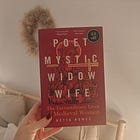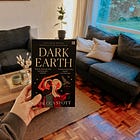Is it legit to reframe historical narratives through fiction?
Review | 'The Good Wife of Bath' by Karen Brooks (2021)
I got in trouble once for saying that feminism didn’t exist in the medieval world.
Apparently that doesn’t go down so well in a world where feminism has become part of the furniture.
But it’s true. Prior to Marxist interpretations of the capitalist world, prior to the suffrage movements of the 19th and 20th centuries, prior to the ongoing and important work to continue chipping away at gender inequality, feminism didn’t exist.
The thing is, though, this doesn’t mean that women didn’t struggle with their lot in life or work to stand on a more equal footing alongside the men in their lives.
As I’ve been exploring in my recent series of biographies focusing on overshadowed women (you can read the first essay HERE), medieval written sources consistently marginalise the words and contributions of women so that reconstructing their experiences becomes fraught with difficulty.
Occasionally, however, we get glimpses of the battles they faced when living under the patriarchal structures of their world - and the creative license of historical fiction stands ready in the wings to reimagine what their lives might have been like.
Because although feminism didn’t exist in the medieval world, it does exist today. And an important part of modern feminism has been recovering the stories of the women who went before us yet weren’t afforded a place in the history books.
The Good Wife of Bath, by Karen Brooks
This review of Karen Brooks’s The Good Wife of Bath (2021) is part of a series of essays sharing books that are working hard to overturn the dominant narratives in medieval history publishing. Frustrated by my own struggles when wandering the aisles of many a bookstore, I want to show that there are books out there that explore more than just kings and battles, opening up more interesting conversations than the same biographies and political histories that we’ve been reading for centuries.
Last month we looked at Hetta Howes’ Poet, Mystic, Widow, Wife, which you can read more about HERE, and next month I’ll be opening up about how I’ve fallen in love with a fiction author who shines the spotlight on real, historical women that disappeared from the records. Make sure to subscribe now to have that review land straight into your email inbox!
How do we react to Chaucer’s Wife of Bath?
Having not studied Chaucer’s Canterbury Tales for close to 20 years, I recently asked on Notes what came to mind when I said the words ‘Wife of Bath’, interested to know if my own caricature matched that of a wider readership.
The responses were fascinating.
A lot focused on her rough character:
Some were slightly more sympathetic:
And others connected with later interpretations:
She’s a divisive character, to say the least, leaving many students and writers scratching their heads about what Chaucer actually meant to do in his presentation of this five-times-widowed, entrepreneurial, independent woman.
Was she bawdy, promiscuous, a loud mouth, and exactly the kind of woman an upstanding fourteenth-century man would run a mile from?
Or was she an enterprising, determined woman seeking to advance in business during an age when women had no place at the negotiating table, making the most of her lot in life?
I can’t imagine that either of these interpretations sat comfortably with the patriarchal ideals of Chaucer’s time - and that’s why I find his decision to create such a character so fascinating. Was she intended to protect the status quo by caricaturing what women can become if they’re allowed to go on pilgrimage unchaperoned and/or engage in business? Or was she intended to be the feminist hero that many later readers have turned her into?
💬 Perhaps those who have studied Chaucer and his world can have a go at answering my questions in the comments: I’d love to know your thoughts!
Marion Turner, J. R. R. Tolkein Professor of English Literature and Language at the University of Oxford and author of The Wife of Bath, says this:
‘Chaucer’s Wife of Bath is one of the most famous characters in English literature … Before the Wife of Bath (whose name is Alison), women in literature were princesses, damsels-in-distress, nuns and queens - or whores, witches and evil old crones. The principal source for the Wife of Bath is an old prostitute. Chaucer’s character is a middle-aged, mercantile, sexually active woman, who gives us her point of view.’1
‘The principal source for the Wife of Bath is an old prostitute.’
Once it’s pointed out, you see it everywhere, with Ruth Evans (1994) arguing that the Wife of Bath sells her body, through her various marriages, for economic gain; she is both broker and commodity.
Might there, however, have been a different origin story for this enigmatic character?
The Wife of Bath is - it’s important to remember - a fictional character, yet one who caricatures the types of women we might have seen had we taken our own pilgrimage to Canterbury in the fourteenth century. In this way, she has shaped our view of medieval women, even if we have the criticality to encounter her as fiction.
Karen Brooks approaches her with sensitivity, using historical fiction to create a more sympathetic reading of the circumstances that might have led to her status as a five-times widow. Hers is a story of sexual assault near-misses, forced marriage, heartbreak, and betrayal. She explores themes of friendship within unorthodox marriages and abuse at the hands of passionate lovers.
Creating an alternative narrative for a character so famous and so associated with her vulgar speech and sexual promiscuity, Brooks invites us to question the stories we have been handed down about medieval women, stories written, ultimately, by men who wanted to maintain the status quo rather than see it threatened by intelligent, capable women.
She invites us, ultimately, to think critically about our sources for the medieval world. Not to argue that Chaucer was ‘bad’ for presenting women negatively; that’s not my point here. But to explore that gap between what women might actually have been like and the way they’ve been portrayed, to help us understand the cultural dynamics at play at the time of writing and to explore the lives that might have acted as inspiration for this most iconic of middle english writers.
So often, as here, the sources available to us for these women are so scant as to be almost unhelpful.
Historical fiction, though it will never recover their lives perfectly or accurately, perhaps restores a little of their stories to the women themselves.
If you enjoyed this review, you might also enjoy these:
https://www.english.ox.ac.uk/article/how-chaucers-medieval-wife-of-bath-was-tamed-and-then-liberated-in-the-21st-century


















I love this topic of imagining what these women’s actual lives were like versus how they were portrayed. I also feel very humble because I have no idea if I’m getting any of the biblical female lives accurate but that’s where my fictional imagination is coming in to imagine how powerful they actually could be. AnyWho, just wanted to throw another reminder up here that on my YouTube channel Deconstructing Patriarchy I have several episodes that started a couple weeks back in regards to how history is made, and the interwoven between history and myth that I think your
Readers would also enjoy
This bit, 'But to explore that gap between what women might actually have been like and the way they’ve been portrayed', made me wonder about how we will be perceived in the future and the gap between the perspective on women from a male vs. female point of view